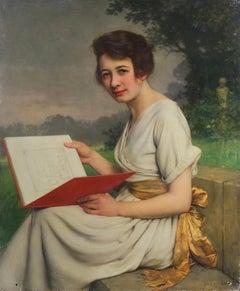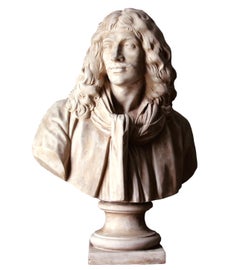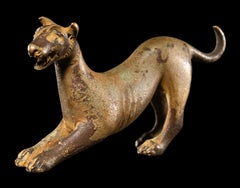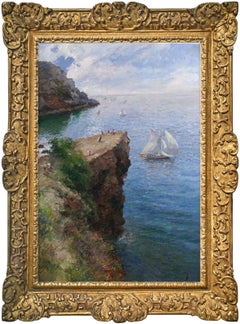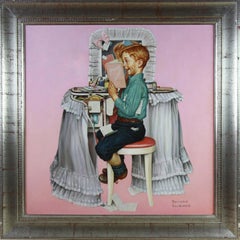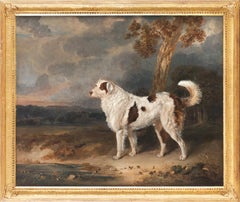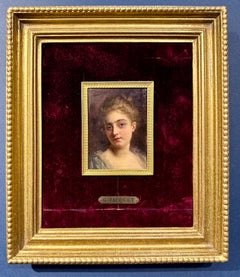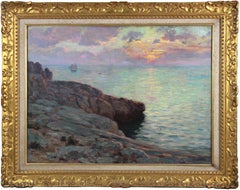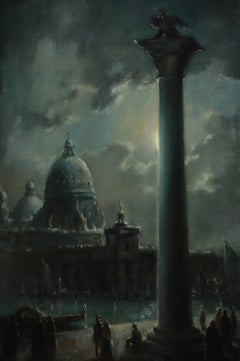Belgium - More Art
to
3
3
2
1
Overall Width
to
Overall Height
to
2
1
6
1
1
1
1
2
1
3
1
1
5
3
3
2
2
2
1
1
1
1
1
1
1
1
1
1
1
5
5
3
3
3
1
1
9,089
3,786
Item Ships From: Belgium
Portrait of a woman in a garden oil painting on panel by Jan Van Beers
By Jan Van Beers
Located in Gavere, BE
Info artist :
Van Beers studied at the Academy in Antwerp. In 1873, he undertook a trip to London with Alexandre Struys. In 1878, Van Beers went to Paris where he worked in the stud...
Category
Early 1900s Victorian Belgium - More Art
Materials
Oil, Wood Panel
Sèvres terracotta Bust Sculpture of Moliere after Jean Antoine Houdon
By Manufacture Nationale de Sèvres
Located in Gavere, BE
Sèvres terracotta Bust Sculpture of Moliere after Jean Antoine Houdon
Bearing the Sèvres mark underneath the base
Additional information about the work:
Title: Bust of Moliere
Med...
Category
1940s Other Art Style Belgium - More Art
Materials
Terracotta
ANCIENT ROMAN BRONZE SCULPTURE FIGURE OF A ROMPING DOG
Located in Milan, IT
"Roman Bronze Figure Of A Romping Dog"
Roman Empire, circa 1st Century B.C.- 1st Century A.D.
Bronze
width 7 cm
width 2 3/4 in
Provenance:
Leo Mildenberg (1913-2001) Private Collection, Zurich, prior to 1986
American Private Collection, acquired in 1991
Literature:
A.P. Kozloff, et al., More Animals in Ancient Art...
Category
15th Century and Earlier Belgium - More Art
Materials
Bronze
Oil painting On Canvas On Panel, Mediterranean View With Sailboat And Cliffs
Located in Gavere, BE
Oil On Canvas On Panel, Mediterranean View With Sailboat And Cliffs ** SOLD WITHOUT FRAME **
Additional information about the work:
Title: Mediterranean View
Medium: oil on canvas...
Category
Late 20th Century Impressionist Belgium - More Art
Materials
Canvas, Oil, Wood Panel
Secrets, oil painting on canvas after Norman Rockwell
By Norman Rockwell
Located in Gavere, BE
Secrets, oil painting on canvas after Norman Rockwell
The original painting was used for the cover of a 1942 Saturday Evening Post.
Hand-painted edition after the Painting of Secre...
Category
1990s Other Art Style Belgium - More Art
Materials
Canvas, Oil
Portrait of a Newfoundland dog, William Smith, British Painting, 1838, Pets Art
Located in Greven, DE
The works of William Smith were regularly exhibited at the Royal Academy in London between 1813 and 1859. Yet little is known about this artist. He lived in Shropshire and was active...
Category
19th Century Romantic Belgium - More Art
Materials
Canvas, Oil
Ancient Greek Terracotta Comic Actor Figurine
Located in Milan, IT
TERRACOTTA FIGURINE OF A COMIC ACTOR , Greece, c. 350 B.C.
Labeled to the reverse, 'LAWRENCE COLL./LOT 426. SOTHEBY./APR. 1892. P. 816.';
Terracotta
height 15.2 cm
height 6 in
Prove...
Category
15th Century and Earlier Belgium - More Art
Materials
Terracotta, ABS
View of a Venetian Harbor oil painting on wood panel 2Oth C
Located in Gavere, BE
View of a Venetian Harbor oil painting on wood panel 2Oth C
Additional information about the work:
Title: View of a Venetian Harbor
Medium: oil on wooden panel
Signature: not sign...
Category
Mid-20th Century Impressionist Belgium - More Art
Materials
Oil, Wood Panel
Early 1900 Art Deco Terracotta Sculpture " a panther on a rock " 19Th
Located in Gavere, BE
Outstanding sculpture depicting a panther in an attacking position, standing on a rock.
The sculpture has a beautiful patina. It displays excellent muscular proportions.
Made from ...
Category
1910s Art Deco Belgium - More Art
Materials
Terracotta, Clay
Related Items
"Mt. Evans and Bierstadt, Colorado" Oil Painting
Located in Denver, CO
David Shingler's (NC based) "Mt. Evans and Bierstadt, Colorado" is an oil painting that depicts a green grassy plain dotted with Pine trees leading to the snow capped mountains in th...
Category
2010s American Impressionist Belgium - More Art
Materials
Oil, Wood Panel
Portrait of a French 19th century lady in a gilt and ormolu hand made frame
By Gustave Jean Jacquet
Located in Woodbury, CT
Gustave Jaquet
Jacquet was born on 25th May 1846 in Paris. He was a pupil of Bouguereau and for his debut at the Paris Salon in 1865, he exhibited 'The Reverie' which was very much i...
Category
1860s Victorian Belgium - More Art
Materials
Oil, Wood Panel
$5,160 Sale Price
20% Off
H 14 in W 12 in
View from Visby, Gotland, c. 1883
Located in Stockholm, SE
This painting by Elisabeth Keyser beautifully captures a scenic view from the northern city wall of Visby, near Lübeckerbräschen. The landscape showcases a stretch of coastline leadi...
Category
1890s Impressionist Belgium - More Art
Materials
Oil, Wood Panel
$4,062 Sale Price
20% Off
H 7.88 in W 12.01 in
Polo Player Bookends in Bronze
Located in Brookville, NY
Polo Bookends in bronze for the sporty library. These were purchased from the collection of a polo player on Long Island who had a beautiful library of sporting books. He also owne...
Category
1960s Academic Belgium - More Art
Materials
Bronze
Country Lane with Trees & Birds in English Countryside by 20th Century Artist
By James Wright
Located in Preston, GB
Country Lane with Trees & Birds in English Countryside by 20th Century British Landscape Artist, James Wright
Signed, Original, Oil on Canvas, housed in a beautiful ornate gold frame.
Provenance: Part of the English Heritage...
Category
1990s Romantic Belgium - More Art
Materials
Canvas, Oil
$1,184 Sale Price
30% Off
H 10 in W 12 in D 2.5 in
Portrait of a Mary Hardy (nee Sulman), Late 19th Century Victorian Oil
Located in London, GB
Slade School
Late 19th Century
Portrait of a Mary Hardy (nee Sulman)
Oil on panel
Image size: 8 x 7 inches
Contemporary frame
Provenance
Lady Town (Grandda...
Category
Late 19th Century Victorian Belgium - More Art
Materials
Oil, Panel
Panther in the Grass, Oil Painting, Landscape, Animal Painting, Illustrator
Located in Houston, TX
Panther in the Grass is by artist Jeff Slemons .There is the use of the palette knife which builds up a texture of the oil paints used in this landscape...
Category
2010s Impressionist Belgium - More Art
Materials
Linen, Oil, Wood Panel
$1,840 Sale Price
20% Off
H 24 in W 24 in D 1 in
Rural Farm House Scene with Hens in English Countryside by 20th Century Artist
By James Wright
Located in Preston, GB
Rural Farm House Scene with Hens in the English Countryside by 20th Century British Artist, James Wright
Signed, Original, Oil on Canvas, housed in a bea...
Category
1990s Romantic Belgium - More Art
Materials
Canvas, Oil
$1,848 Sale Price
30% Off
H 17 in W 21 in D 2.5 in
Fine 16th Century Flemish Old Master Oil on Panel The Holy Family Museum Quality
Located in Cirencester, Gloucestershire
The Holy Family
attributed to Adrien Thomas Key (Flemish c.1544-1590)
oil painting on wood panel (cradled): 24 x 26 inches
frame: 34 x 35 inches
condition: for its considerable age, ...
Category
16th Century Mannerist Belgium - More Art
Materials
Wood Panel, Oil
$17,334
H 34 in W 35 in D 1 in
The Feathered Hat
Located in San Francisco, CA
There something so poignant about this 40-something woman, painted sometime after World War I by F. Harding. She’s in her plain but “Sunday best” clothes. Yet she unwrapped for this ...
Category
1930s Impressionist Belgium - More Art
Materials
Oil, Wood Panel
Dutch Old Master Portrait of Maurits, Prince of Orange-Nassau, Oil on Panel
Located in London, GB
In 1607, the Delft city council decided to commission a portrait of Stadholder Maurits of Nassau for the town hall, with Michiel van Mierevelt as the chosen artist due to the passing...
Category
17th Century Old Masters Belgium - More Art
Materials
Oil, Wood Panel
$12,261
H 37.8 in W 33.47 in D 2.37 in
Unrivaled Fascination: White Cow's Energetic Presence on a Dark Surface.
Located in Zofingen, AG
The depiction of a young white cow on a black background using oil paints creates a unique and captivating painting. Its endlessly playful expression gives the artwork a special char...
Category
21st Century and Contemporary Romantic Belgium - More Art
Materials
Oil, Canvas, Cotton Canvas
$1,414
H 23.63 in W 17.72 in D 1.19 in
Previously Available Items
Marine seascape at sunset French oil on canvas by Charles Signoret 19Th century
Located in Gavere, BE
Marine seascape at sunset French oil on canvas by Charles Signoret 19Th century
Description:
Title : seascape at sunset
Provenance: French private collection
Dimensions of the pai...
Category
Early 1900s Impressionist Belgium - More Art
Materials
Gold Leaf
H 27.96 in W 35.04 in D 1.58 in
Venice at full moon oil painting on wooden panel 2Oth C
Located in Gavere, BE
Venice at full moon oil painting on wooden panel 2Oth C
Additional information about the work:
Title: Venice at full moon
Medium: oil on wooden panel
Signature: not signed
Proven...
Category
Mid-20th Century Impressionist Belgium - More Art
Materials
Oil, Wood Panel
19th C Bronze Sclptured Hand holding a Bird
Located in brussel, BE
19th C Bronze Sclptured Hand holding a Bird fixed on a concrete pedestal.Very nice patina.
Category
19th Century Belgium - More Art
Materials
Bronze
Henri Van Hoeter (1871- ), Bronze Portrait Buste of a Young Man, signed
Located in brussel, BE
This is a lovely 1930's C bronze bust signed by the Art Deco sculptor Henry Van Hoeter.
Category
1930s Art Deco Belgium - More Art
Materials
Bronze
H 16.93 in W 7.88 in D 6.3 in
19th C, French School, Caricatures of Two Pleading Lawyers
By Honoré Daumier
Located in brussel, BE
In preparation for his caricatures, Daumier made a series of small-scale portrait busts of parliamentarians and people from judicial circles in unbaked clay, coloured with paint. Ass...
Category
19th Century French School Belgium - More Art
Materials
Metal
Santa Cruz People, Solomon Islands, Teveau Feather Currency
Located in brussel, BE
Feather money was used on the Santa Cruz archipelago, a remote group forming part of the Solomon Islands for a very long time. The feather money consiste...
Category
20th Century Other Art Style Belgium - More Art
Materials
Organic Material
17th C, Baroque, Biblical, Jesus and the Samaritan Woman by the Well
Located in brussel, BE
The painter of this canvas copied a composition of the Italian Baroque painter Annibale Carracci (Bologna, 1560- Rome, 1609). The original painting (oil on canvas, 170 x 225 cm) by Carracci is now preserved in the Pinacoteca di Brera. “Our artist” probably based himself on a reproduction print after the Carracci painting. In 1610 the French publisher, François Langlois...
Category
17th Century Baroque Belgium - More Art
Materials
Canvas, Oil
H 19.69 in W 23.23 in D 1.97 in
Decoratif Ceremonial Beaded Palm Wine Vessel, Cameroon Grasslands
Located in brussel, BE
Throughout the many Kingdoms in the Cameroon Grasslands region (Bamileke - Bamum - Tikar) employed a range of Regalia to assert their political, economic and religious power. Presented publicly in lavish displays of wealth and power, many court objects distinguished their elaborate bead embroidery. Of the many ritual items...
Category
20th Century Tribal Belgium - More Art
Materials
Glass
Decoratif Ceremonial Beaded Palm Wine Vessel topped with Animal Figure
Located in brussel, BE
Throughout the many Kingdoms in the Cameroon Grasslands region (Bamileke - Bamum - Tikar) employed a range of Regalia to assert their political, economic and religious power. Presented publicly in lavish displays of wealth and power, many court objects distinguished their elaborate bead embroidery. Of the many ritual items...
Category
20th Century Tribal Belgium - More Art
Materials
Glass
H 32.68 in Dm 10.63 in
Decorative Palm Wine Vessel from the Cameroon Grasslands with leopard figure
Located in brussel, BE
Throughout the many Kingdoms in the Cameroon Grasslands region (Bamileke - Bamum - Tikar) employed a range of Regalia to assert their political, economic and religious power. Presented publicly in lavish displays of wealth and power, many court objects distinguished their elaborate bead embroidery. Of the many ritual items...
Category
20th Century Tribal Belgium - More Art
Materials
Glass
H 32.68 in Dm 10.24 in
Decorative Palm Wine Vessel from the Cameroon Grasslands with leopard figure
Located in brussel, BE
Throughout the many Kingdoms in the Cameroon Grasslands region (Bamileke - Bamum - Tikar) employed a range of Regalia to assert their political, economic and religious power. Presented publicly in lavish displays of wealth and power, many court objects distinguished their elaborate bead embroidery. Of the many ritual items...
Category
20th Century Tribal Belgium - More Art
Materials
Glass
H 32.68 in Dm 10.24 in
Decorative Palm Wine Vessel from the Cameroon Grasslands
Located in brussel, BE
Throughout the many Kingdoms in the Cameroon Grasslands region (Bamileke - Bamum - Tikar) employed a range of Regalia to assert their political, economic and religious power. Presented publicly in lavish displays of wealth and power, many court objects distinguished their elaborate bead embroidery. Of the many ritual items...
Category
20th Century Tribal Belgium - More Art
Materials
Glass
